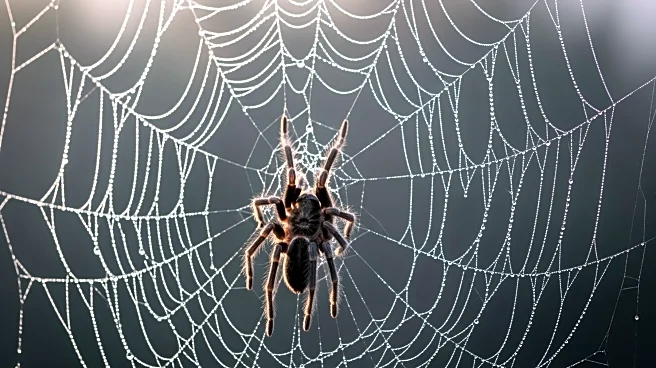What's Happening?
In the rugged mountains above Los Angeles, the tarantula mating season is underway, typically peaking in October following the first autumn rains. Male tarantulas emerge from their burrows in search of
mates, a quest fraught with danger as female tarantulas are known to consume their suitors. Rodrigo Monjaraz Ruedas, assistant curator of entomology at the Natural History Museum of L.A. County, explains that even after mating, males must quickly escape to avoid being eaten. The mating season, which runs from July to November, offers the best chance to observe these arachnids, particularly in areas like the Angeles National Forest and Santa Monica Mountains. California hosts ten species of tarantulas, including the California ebony tarantula and the desert-dwelling Aphonopelma iodius.
Why It's Important?
The tarantula mating season highlights the delicate balance of survival in the wild, where natural behaviors can lead to perilous outcomes. This period is crucial for the continuation of tarantula populations, as successful mating can result in hundreds of offspring, though many do not survive. The presence of tarantulas in urban areas poses additional risks, such as drowning in pools or being hit by vehicles. Understanding these dynamics is important for conservation efforts and for educating the public about the ecological role of tarantulas. The Natural History Museum's spider pavilion offers an opportunity for visitors to learn about these creatures and their habitats.
What's Next?
As the mating season progresses, conservationists and entomologists may focus on protecting tarantula habitats from urban encroachment and educating the public on how to coexist with these spiders. The Natural History Museum's ongoing exhibits provide a platform for raising awareness about tarantula behavior and the importance of preserving their natural environments. Future studies may explore the impact of climate change on tarantula populations and their mating patterns.
Beyond the Headlines
The tarantula mating season underscores broader ecological themes, such as the impact of urbanization on wildlife and the importance of biodiversity. It also raises ethical considerations regarding human interaction with natural habitats and the need for sustainable development practices. The fascination with tarantulas can foster a deeper appreciation for the complexity of ecosystems and the interconnectedness of species.













